
In the flat shade mode, the following pyramid would be displayed with a sharp edge between adjoining faces. In the Gouraud shade mode, however, shading values would be interpolated across the edge, and the final appearance would be of a curved surface.

The Gouraud shade mode lights flat surfaces more realistically than the flat shade mode. A face in the flat shade mode is a uniform color, but Gouraud shading allows light to fall across a face correctly. This effect is particularly obvious if there is a nearby point source.
Gouraud shading smoothes out the sharp edges between polygons that are visible with flat shading. However, it can result in Mach bands, which are bands of color or light that are not smoothly blended across adjacent polygons. Your application can reduce the appearance of Mach bands by increasing the number of polygons in an object, increasing screen resolution, or by increasing the color depth of the application.
Gouraud shading can miss some details. One example is the case shown by the following illustration, in which a spotlight is completely contained within a polygonal face.

In this case, the Gouraud shade mode, which interpolates between vertices, would miss the spotlight altogether; the face would be rendered as though the spotlight did not exist.